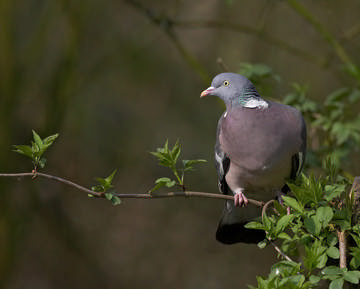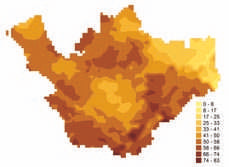
Woodpigeon © Richard Steel
Woodpigeon is now the sixth most abundant species in Cheshire and Wirral, with a breeding population in 2004-05 of 129,890 birds (102,450-157,330), corresponding to an average of almost 200 birds per tetrad in which they were found. The abundance map shows that they were least numerous in the eastern hills and in the most wooded parts of the county, in north-east Cheshire and the centre around Delamere, with highest densities in agricultural areas. The distribution map shows that they were present almost everywhere in this Atlas, as they were twenty years ago. Their numbers are probably higher, however, as the national breeding population index has risen steadily year on year, and was up by 60% in the twenty years since 1984.
Their move into suburban and urban areas, first started in about the 1930s, is now complete and modern Woodpigeons appear to have little fear of man. The habitat codes showed 2.5% of records in urban areas and 7.5% in suburbia, with 9% in rural human sites. 37% of records were in farmland habitats, 36% in woodland and 6% in scrub.
They have an extended breeding season, at least from April to October, but most successful nests come later in the season, from July onwards, when the nests are better hidden by leaves and there are far more seeds available for the adults to eat (Murton 1965). They may well nest earlier in urban areas but the switch to autumn sowing, and thus earlier ripening, of cereals has helped them advance their breeding season in farmland (O’Connor & Shrubb 1986). The flourishing population in Sefton Park, Liverpool is more akin to farmland birds in their timing, perhaps because they feed especially on oilseed rape, flying at least 6 km away from the nest to fields outside the city (Slater 2001). This strategy obviously works because the nests of those pairs, and perhaps those of similar habit in Cheshire and Wirral, are much more successful in raising young than is found in farmland nests.

Woodpigeon abundance.
Fieldworkers proved breeding in two-thirds of tetrads, usually by finding a nest, sometimes given away by an egg shell on the ground beneath. Henry Finch, whilst surveying near Alvanley (SJ47W), had the unusual experience of recording a nest’s contents by seeing an ‘obliging’ crow remove an egg. Their nests are built of a few twigs, often so flimsy that the eggs can be seen from the ground underneath, birds often drawing attention to them by uttering a soft ‘coo’ close to the nest. Typical sites are hawthorn hedges and creepers such as ivy, but many birds build in trees, of almost any species. Perhaps a measure of their high density is that nests were found on girders in barns and in industrial sites, more typically the habitat of Feral Pigeons or Collared Doves. An urban myth says that ‘you never seen baby pigeons’ but observers in 88 tetrads found recently fledged youngsters, perhaps none as easily as Marc Granville who had them come into his Holmes Chapel garden (SJ76T) and comically try using his children’s climbing frame from which to learn to fly.
Sponsored by by David and Fran Cogger in memory of Jasper

